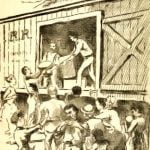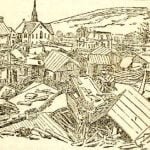
Hundreds have been laid away in shallow trenches without forms, ceremonies or mourners. All day long the work of burial has been going on. There was no time for religious ceremonies or mourning and many a mangled form was coffined with no sign of mourning save the honest sympathy of the brave men who handled them. As fast as the wagons that are gathering up the corpses along the stream arrive with their ghastly loads they are emptied and return again to the banks of the merciless Conemaugh to find other victims among the driftwood in the underbrush, or half buried in the mud. The coffins are now beginning to arrive, and on many streets on the hillside they are stacked as high as the second and third story windows.
At Kernville the people are not so fortunate. It would seem that every man is his own coffin maker, and many a man can be seen here and there claiming the boards of what remains of his house in which perhaps he has found the remains of a loved one, and busily patching them together with nails and hoops or any available thing to hold the body.
When the corpses are found they are taken to the nearest dead house and are carefully washed. They are then laid out in rows to await identification. Cards are pinned to their breasts as soon as they are identified, and their names will be marked on the headboards at the graves.
Wholesale Funerals
There were many rude funerals in the upper part of the town. The coffins were conveyed to the cemeteries in wagons, each one carrying two, three or more.
At Long View Cemetery and at one or two other points long trenches have been dug to receive the coffins. The trenches are only about three feet deep, it being thought unnecessary to bury deeper, as almost all the bodies will be removed by friends. Nearly three hundred bodies were buried thus today.
There will be no public ceremony, no funeral dirge, and but few weeping mourners. The people are too much impressed with the necessity of immediate and constant work to think of personal grief.
The twenty-six bodies taken to the hose house in Minersville were buried shortly after ten o’clock yesterday morning. Of the twenty-six, thirteen were identified. Eight women, a baby and four men were buried without having been identified.
All day yesterday men were engaged in burying the dead. They ran short of coffins, and in order to dispose of the rapidly decomposing bodies they built rough boxes out of the floating lumber that was caught. In this way they buried temporarily over fifty bodies in the cemetery just above the town.
Putrefaction of dead bodies threatens the health of the whole region. Now that the waters are fast shrinking back from the horrid work of their own doing and are uncovering thousands of putrid and ill-smelling corpses the fearful danger of pestilence is espied, stalking in the wake of more violent destruction.
The air is already reeking with infectious filth, and the alarm is widespread among the desolated and overwrought population.
Cremation Best
Incident to this phase of the situation the chief sensation of the morning was the united remonstrance of the physicians against the extinguishment of the burning wreck of the demolished town which is piled up against the bridge. They maintain, with a philosophy that to anxious searchers seems heartless, that hundreds, if not thousands, of lifeless and decaying bodies lie beneath this mass of burning ruins.
“It would be better,” they say, “to permit Nature’s greatest scavenger–the flames–to pursue his work unmolested than to expose to further decay the horde of putrefying bodies that lie beneath this débris. There can be but one result. Days will elapse before the rubbish can be sufficiently removed to permit the recovery of these bodies, and long before that every corpse will be a putrid mass, giving forth those frightful emanations of decaying human flesh that in a crowded community like this can have but one result–the dreadful typhus. Every battlefield has demonstrated the necessity of the hasty interment of decaying bodies, and the stench that already arises is a forerunner of impending danger. Burn the wreck, burn the wreck.”
Sorrow Rejects Safety

A loud cry of indignation arose from the lips of the vast multitude and the warnings of science were lost in the eager demands of those that sought the remains of the near and dear. The hose was again turned upon the hissing mass, and rapidly the flames yielded to the supremacy of water.
It is almost impossible to conceive the extent of these smoking ruins. An area of eight or ten acres above the dam is covered to a depth of forty feet with shattered houses, borne from the resident centre of Johnstown. In each of these houses, it is estimated, there were from one to twenty or twenty-five people. This is accepted as data upon which to estimate the number that perished on this spot, and if the data be correct the bodies that lie beneath these ruins must run well up into the thousands.
Members of the State Board of Health arrived in Nineveh this morning and determined to proceed at once to dredge the river, to clean it of the dead and prevent the spreading of disease. To this end they have wired the State Department to furnish them with the proper appliances.
Drinking Poisoned Water
From other points in this and connecting valleys the same fear of pestilence is expressed. The cities of Pittsburgh and Allegheny, which have a population of three hundred and fifty thousand and drink the waters of the Allegheny River, down which corpses and débris from Johnstown must flow unless stopped above, are in danger of an epidemic. The water is to-day thick with mud, and bodies have been found as far south of here as Beaver, a distance of thirty miles below Pittsburgh. To go this distance the bodies followed the Conemaugh from Johnstown to the Kiskiminetas, at Blairsville, joining the Allegheny at Freeport, and the Ohio here, the entire distance from this point being about one hundred and fifty miles.
“This is a very serious matter,” said a prominent Pittsburgh physician who is here to me to-day, “and one that demands the immediate attention of the Board of Health officials. The flood of water that swept through Johnstown has cleaned out hundreds of cesspools. These and the barnyards’ manure and the dirt from henneries and swamps that were swept by the waters have all been carried down into the Allegheny River. In addition to this there are the bodies of persons drowned. Some of these will, in all likelihood, be secreted among the débris and never be found. Hundreds of carcasses of animals of various kinds are also in the river.
Typhus Dreaded
“These will decay, throwing out an animal poison. This filth and poisonous matter is being carried into the Allegheny, and will be pumped up into the reservoir and distributed throughout the city. The result is a cause for serious apprehension. Take, for example, the town of Hazleton, Pa. There the filth from some outhouse was carried into the reservoir and distributed through the town. The result was a typhoid fever epidemic and hundreds of people lost their lives. The water that we are drinking to-day is something fearful to behold.”
The municipal authorities of Pittsburgh have issued a notice embodying the above facts.
Sanitary Work
A message was received by the Relief Committee this morning confirming the report that for the health of the cities of Pittsburgh and Allegheny it is absolutely necessary that steps be taken immediately to remove the bodies and drift from the river, and begging the committee to take early action. The contract for clearing the river was awarded to Captain Jutte, and he will start up the Allegheny this afternoon as far as Freeport, and then work down. His instructions are to clear the river thoroughly of anything that might in any way affect the water supply.
Helping Hands
The work of relief at the scene of the great disaster is going on rapidly. The Alliance (Ohio) Relief Committee arrived here this morning on a special train with five carloads of provisions. The party is composed of the most prominent iron and steel merchants of Alliance.
They have just returned from a tour of the ruined town. They have been up to Stony Creek, a distance of five miles and up the Conemaugh River toward South Fork, a distance of two miles.
In describing their trip, one of their number said:–“I tell you the half has never been told. It is impossible to tell the terrible tale. I thought I had seen horrible sights, and I served five years in the War of the Rebellion, but in all my life it has never been my lot to look upon such ghastly sights as I have witnessed to-day.
“While making the circuit of the ruined places we saw 103 bodies taken out of the débris along the bank of the river and Stony Creek. Of this number, we identified six of the victims as our friends.”
Discover more from Access Genealogy
Subscribe to get the latest posts sent to your email.
